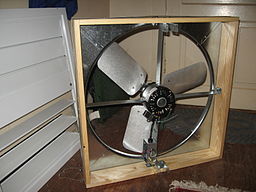Who Can Fix My Whole House Fan?
 A whole house fan is an efficient home cooling device, suitable for any homeowner who likes to save money and reduce their carbon footprint -- and isn't that just about everyone? Inexpensive and uncomplicated to install, a whole house fan also features amazingly low electrical consumption. But as with any appliance, things can occasionally go wrong. Learn how to troubleshoot common problems and find the right person to fix your whole house fan.
A whole house fan is an efficient home cooling device, suitable for any homeowner who likes to save money and reduce their carbon footprint -- and isn't that just about everyone? Inexpensive and uncomplicated to install, a whole house fan also features amazingly low electrical consumption. But as with any appliance, things can occasionally go wrong. Learn how to troubleshoot common problems and find the right person to fix your whole house fan.
What is a Whole House Fan?
As its name suggests, this type of cooling system is basically an oversized fan, which is usually installed in your attic. Designed to work at night or other times when the outdoor temperature is lower than the indoors, a whole house fan functions according to a simple principle: it pushes hot air out of your home and pulls cool air in via your open windows. The fan then circulates this cool air throughout the house. Cost to operate: a mere 1-5 cents per hour ... unless your system is solar powered, in which case it costs nothing to run. Compare that to the hourly price of air conditioning, which runs as high as $.15-.20.
What Can Go Wrong?
When your fan is not working as it should, refer to the following list to help you troubleshoot the problem:
- The fan isn't operating at all. Is the electric power connected and functioning? Might there be a problem with the outlet or extension cord you are using? Has a main breaker or GFCI breaker been tripped or a fuse blown? Could a malfunctioning thermostat be causing the trouble? If not, the problem is probably inside the fan itself -- such as loose wiring or a burnt out motor (the costliest of all whole house fan repairs).
- The motor is running but the fan blades do not spin. The whole house fan motor belt may be loose or broken, in which case it will need replacement.
- The fan operates for a while and then stops. The internal thermal sensor may be automatically switching your unit off due to malfunction, inadequate attic ventilation, or a faulty motor bearing or fan shaft bearing.
- The fan is making an annoying humming sound. Activate the anti-hum feature or run the fan on low speed. You can avoid this problem in the first place by purchasing a higher quality whole house fan.
- The louvers rattle. Make sure there is enough air around the fan, with at least 30 inches of clearance over the blades, and open the windows of your house for circulation.
Who Can Repair a Whole House Fan and How Much Will it Cost?
If the fan is still within its warranty period, contact the repair service authorized by the manufacturer. Don't attempt to fix your unit "on the cheap," as this may invalidate the unit's warranty. Even if the warranty has expired, it is important to find a licensed electrician who has experience with this type of appliance.
Depending on the problem, the cost to repair your whole house fan will generally run about $250-350. If it turns out that your fan is beyond saving, whole house fan replacement cost depends on the size and model you choose. It will come out to approximately $300-650 for a new unit together with related hardware and supplies, plus another $120-220 for labor. There may be an additional charge for getting rid of the non-functioning fan, as well.
Laura Firszt writes for networx.com.
Updated March 11, 2018.
Looking for a Pro? Call us (866) 441-6648

Electrical Average Costs
Electricians Experiences

Replacement Of A Light Fixture That Literally Fell Off The Ceiling

Electrical Upgrade Including New Breakers And Replacement Wiring



